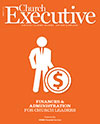
By Rev. James R. Cook, CFP®
 A new employee has fulfilled their probationary period and is now eligible to receive the full benefits offered by your organization. Yet, many eligible employees choose not to contribute to their retirement — even if it means leaving matching employer contributions on the table.
A new employee has fulfilled their probationary period and is now eligible to receive the full benefits offered by your organization. Yet, many eligible employees choose not to contribute to their retirement — even if it means leaving matching employer contributions on the table.
Access to a retirement plan is a valuable benefit so it’s no wonder that many church employers are asking, “How can we boost enrollment in our retirement plan?”
Here are some things you can do.
 #1: Offer auto-enrollment and auto-escalation of employee contributions. Auto-enrollment makes a huge change in participation. Behavioral economic research shows that auto-enrollment features can increase employee participation in retirement savings to as high as 90 percent.
#1: Offer auto-enrollment and auto-escalation of employee contributions. Auto-enrollment makes a huge change in participation. Behavioral economic research shows that auto-enrollment features can increase employee participation in retirement savings to as high as 90 percent.
While employees have the option to opt out of the retirement plan, enrollment is the default option. Staff are automatically enrolled in the retirement plan at a minimum contribution percentage with contributions going into a default investment option. Most plans offer employees the chance to change the fund selection once they’re enrolled. In a Vanguard study published in January 2015, participation rates among new hires more than double — to 91 percent — under automatic enrollment, compared with 42 percent under voluntary enrollment.
Auto-escalation assures that staff contributions to their retirement savings increase over time in a way that minimizes the cash flow implications while boosting saving levels. Too often, participants do not increase their contribution rate and develop a false sense of security when they actually might not be saving enough.
When auto-escalation is added, employee contributions are increased by a predetermined percentage annually until they reach a predetermined cap. For example, an employee making $50,000 might be enrolled with a 3-percent default annual savings rate of $1,500 that increases by 1 percent each year until they reach a 10-percent annual rate. In some cases, participants can choose their own auto-escalation schedule.
#2: Offer a matching contribution or change your current match formula. An employer matching contribution is also a proven incentive towards increased participation. The greater the employer match, the bigger the impact on enrollment.
Typically, employees will contribute the amount needed to receive the matching funds because few people will refuse the sense of collecting “free” money in their retirement accounts. Employee matching plans are already quite popular, and 2013 figures indicate that close to 80 percent of employers offer one.
If you’ve had the same matching formula for some time, consider modifying it slightly. This might motivate employees who already participate in the plan to increase their own contribution.
Changing the match formula doesn’t have to increase the employer’s contribution. Imagine a plan where an employer matches 100 percent of an employee’s contribution up to 3 percent of compensation. Changing the match to 50 perent of an employee’s contribution up to 6 percent of compensation keeps the employer’s cost the same while encouraging employees to double their contribution.
#3: Pay attention to how you communicate about your retirement plan. What you say about your plan matters. Pay attention to what you say about your retirement benefits, how you get your message across, and the frequency of your communications.

Many employers emphasize the mechanics of their plans — how to enroll, and how the plan works. Employees often tune out communications that focus on the logistics; however, research shows that they respond to communication that’s personalized and connects directly to their retirement goals.
Encourage plan participants to envision what their retirement might look like in terms of retirement income and the lifestyle it might allow them to lead. Communication that’s motivational, focuses on positive outcomes, and offers examples of participant success stories will help members appreciate the value of automatic features that can lead to higher contributions and greater retirement readiness. Use a variety of mediums — from web-based and mobile educational tools, to newsletters and statements — to reach out to staff on retirement readiness.
#4: Offer one-to-one meetings with professionals. Educational resources are important, but the opportunity to meet face-to-face with a financial planner or advisor provides a chance for participants to review their retirement portfolio and determine if they’re on target to meet their goals.
A recent study determined that 71 percent of participants give high marks to meeting with a financial professional and found that those who have met with a financial planner are more likely to build an investment portfolio that balances their investment risk tolerance with a need for returns that meets their retirement needs.
All of the above efforts will require a carefully crafted strategy; but, in the long run — separately or together — they will lead to the increased enrollment that you desire.
Rev. James R. Cook, CFP®, is a National Outreach Manager at MMBB Financial Services. As a Certified Financial Planner™ professional, Cook is an expert in comprehensive financial and retirement planning. He is also an accomplished speaker and a passionate teacher with 10 years of pastoral experience in several California churches.


